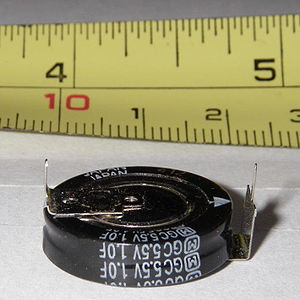Farad
- Tidak sama dengan satuan faraday. Untuk pemukiman zaman kuno di California, lihat Farad, California.
Farad (symbol: F) merupakan satuan turunan SI untuk kapasitansi listrik, yaitu kemampuan suatu benda untuk menyimpan muatan listrik. Dinamakan menurut fisikawan Inggris, Michael Faraday.
| Farad | |
|---|---|
 Suatu kapasitor 1 farad yang relatif kecil, untuk voltage dan aliran listrik rendah | |
| Informasi umum | |
| Satuan turunan SI | |
| Besaran | Kapasitansi |
| Simbol | F |
Asal penamaan | Michael Faraday |
| Dalam satuan dasar SI: | 1 F = 1 s4·A2·m−2·kg−1 |
Definisi
Satu farad didefinisikan sebagai kapasitansi suatu kapasitor yang dilintasi oleh listrik dengan muatan satu coulomb, sehingga terdapat perbedaan potensial listrik sebesar satu volt.[1] Kebalikannya, merupakan kapasitansi yang ketika dialiri listrik dengan perbedaan potensial satu volt, bermuatan satu coulomb.[2] Satu coulomb sama dengan jumlah muatan (elektron) yang dihasilkan oleh aliran sebesar satu ampere (A) yang mengalir selama satu detik.
For most applications, the farad is an impractically large unit of capacitance. Most electrical and electronic applications are covered by the following SI prefixes:
- 1 mF (millifarad, one thousandth (10−3) of a farad) = 1000 μF = 1000000 nF
- 1 μF (microfarad, one millionth (10−6) of a farad) = 1000 nF = 1000000 pF
- 1 nF (nanofarad, one billionth (10−9) of a farad) = 1000 pF
- 1 pF (picofarad, one trillionth (10−12) of a farad)
Equalities
A farad has the base SI representation of: s4 × A2 × m−2 × kg−1
It can further be expressed as:
where A=ampere, V=volt, C=coulomb, J=joule, m=metre, N=newton, s=second, W=watt, kg=kilogram, Ω=ohm, H=henry.
History
The term "farad" was coined by Josiah Latimer Clark in 1861, in honor of Michael Faraday, but it was for a unit of quantity of charge.[perlu dijelaskan]
Explanation
A capacitor consists of two conducting surfaces, frequently referred to as plates, separated by an insulating layer usually referred to as a dielectric. The original capacitor was the Leyden jar developed in the 18th century. It is the accumulation of electric charge on the plates that results in capacitance. Modern capacitors are constructed using a range of manufacturing techniques and materials to provide the extraordinarily wide range of capacitance values used in electronics applications from femtofarads to farads, with maximum-voltage ratings ranging from a few volts to several kilovolts.
Values of capacitors are usually specified in farads (F), microfarads (μF), nanofarads (nF) and picofarads (pF).[3] The millifarad is rarely used in practice (a capacitance of 4.7 mF (0.0047 F), for example, is instead written as 4700 µF), while the nanofarad is uncommon in North America.[4] The size of commercially available capacitors ranges from around 0.1 pF to 5000F (5 kF) supercapacitors. Parasitic capacitance in high-performance integrated circuits can be measured in femtofarads (1 fF = 0.001 pF = 10−15 F), while high-performance test equipment can detect changes in capacitance on the order of tens of attofarads (1 aF = 0.000001 pF = 10−18 F).[5]
A value of 0.1 pF is about the smallest available in capacitors for general use in electronic design, since smaller ones would be dominated by the parasitic capacitances of other components, wiring or printed circuit boards. Capacitance values of 1 pF or lower can be achieved by twisting two short lengths of insulated wire together.[6][7]
The capacitance of the Earth's ionosphere with respect to the ground is calculated to be about 1 F.[8]
Informal terminology
The picofarad is sometimes colloquially pronounced as "puff" or "pic", as in "a ten-puff capacitor".[9] If the Greek letter μ is not available, the notation "uF" is often used as a substitute for "μF" in electronics literature. A "micro-microfarad" (μμF, and confusingly often mmf or MMF), an obsolete unit sometimes found in older texts, is the equivalent of a picofarad.[10] Industrial parts (e.g. automotive, lighting) sometimes use the abbreviation MFD instead of µF.[11]
Related concepts
The reciprocal of capacitance is called electrical elastance, the (non-standard, non-SI) unit of which is the daraf.[12]
CGS units
The abfarad (abbreviated abF) is an obsolete CGS unit of capacitance equal to 109 farads (1 gigafarad, GF). This very large unit is used in medical terminology only.
The statfarad (abbreviated statF) is a rarely used CGS unit equivalent to the capacitance of a capacitor with a charge of 1 statcoulomb across a potential difference of 1 statvolt. It is 1/(10-5c2) farad, approximately 1.1126 picofarads. -->
Lihat pula
Referensi
- ^ The International System of Units (SI) (PDF) (edisi ke-8th). Bureau International des Poids et Mesures (International Committee for Weights and Measures). 2006. hlm. 144.
- ^ Peter M B Walker, ed. (1995). Dictionary of Science and Technology. Larousse. ISBN 0752300105.
- ^ Braga, Newton C. (2002). Robotics, Mechatronics, and Artificial Intelligence. Newnes. hlm. 21. ISBN 0-7506-7389-3. Diakses tanggal 2008-09-17.
Common measurement units are the microfarad (μF), representing 0.000,001 F; the nanofarad (nF), representing 0.000,000,001 F; and the picofarad (pF), representing 0.000,000,000,001 F.
- ^ Platt, Charles (2009). Make: Electronics: Learning Through Discovery. O'Reilly Media. hlm. 61. ISBN 9781449388799. Diakses tanggal 2014-07-22.
Nanofarads are also used, more often in Europe than in the United States.
- ^ Gregorian, Roubik (1976). Analog MOS Integrated Circuits for Signal Processing. John Wiley & Sons. hlm. 78.
- ^ Pease, Bob (2 September 1993). "What's All This Femtoampere Stuff, Anyhow?". Electronic Design. Diakses tanggal 2013-03-09.
- ^ Pease, Bob (1 December 2006). "What's All This Best Stuff, Anyhow?". Electronic Design. Diakses tanggal 2013-03-09.
- ^ Williams, L. L. (January 1999). "Electrical Properties of the Fair-Weather Atmosphere and the Possibility of Observable Discharge on Moving Objects" (PDF). Diakses tanggal 2012-08-13.
- ^ "Puff". Wolfram Research. Diakses tanggal 2009-06-09.
- ^ In texts prior to 1960, mf rather than the modern µF frequently represented microfarads. Similarly, mmf represented picofarads.
- ^ "Microfarad". The Free Dictionary. Diakses tanggal 2012-08-13.
- ^ "Daraf". Webster's Online Dictionary. Diakses tanggal 2009-06-19.